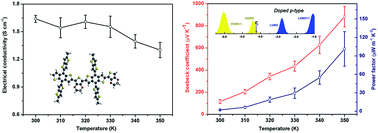Thermoelectrics of two-dimensional conjugated benzodithiophene-based polymers: density-of-states enhancement and semi-metallic behavior†
Abstract
With the good planarity of conjugated backbones and high carrier mobilities, two-dimensional conjugated benzodithiophene (BDT)-based polymers find great potential in renewable energy conversion and storage. In this work, two BDT-based alternative copolymers, P(BDT-EDOT) and two-dimensional conjugated P(BDTTT-EDOT), are designed and synthesized to systematically investigate the influence of two-dimensional conjugated structures on the thermoelectric performance of conjugated polymers. Compared with P(BDT-EDOT) films, the larger Seebeck coefficient of doped P(BDTTT-EDOT) films (115.58 μV K−1) can be attributed to the enhancement of the density of states around the Fermi level, which is proved by the ultraviolet photoemission spectroscopy measurement and Mott parameters calculation. The electrical conductivities of doped P(BDTTT-EDOT) films are gradually decreased with the increasing temperature, and a large Seebeck coefficient above 800 μV K−1 is achieved at 350 K, indicating their semi-metallic behavior. The power factor of doped P(BDTTT-EDOT) films can reach 101.3 μW m−1 K−2 at 350 K, which is more than 100 times higher than that of the P(BDT-EDOT) film (0.9 μW m−1 K−2) at 350 K.



 Please wait while we load your content...
Please wait while we load your content...